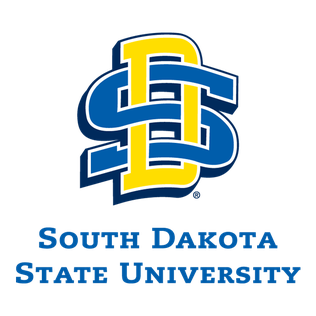
South Dakota State University is a public land-grant research university in Brookings, South Dakota. Founded in 1881, it is the state's largest and most comprehensive university and the oldest continually operating university in South Dakota. The university is governed by the South Dakota Board of Regents, which governs the state's six public universities and two special schools.

Missouri State University, formerly Southwest Missouri State University, is a public university in Springfield, Missouri. Founded in 1905 as the Fourth District Normal School, it is the state's second largest university by enrollment, with an enrollment of 23,307 at its main campus in the fall semester of 2022. The school also operates a campus in West Plains, Missouri offering associate degrees, which had an enrollment of 1,744 in the fall semester of 2022. A bachelor's degree in business is offered at Liaoning Normal University in China. The university also operates a fruit research station in Mountain Grove, Missouri and a Department of Defense and Strategic Studies program in Fairfax, Virginia.

Temple University is a public state-related research university in Philadelphia, Pennsylvania. It was founded in 1884 by the Baptist minister Russell Conwell and his congregation Grace Baptist Church of Philadelphia then called Baptist Temple. On May 12, 1888, it was renamed the Temple College of Philadelphia. By 1907, the institution revised its institutional status and was incorporated as a research university.

Seton Hall University (SHU) is a private Roman Catholic research university in South Orange, New Jersey. Founded in 1856 by then-Bishop James Roosevelt Bayley and named after his aunt, Saint Elizabeth Ann Seton, Seton Hall is the oldest diocesan university in the United States.
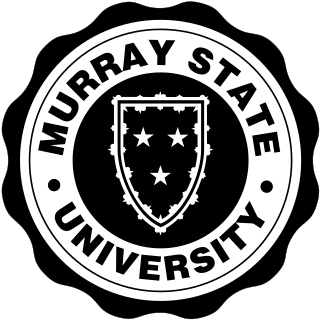
Murray State University (MSU) is a public university in Murray, Kentucky. In addition to the main campus in Calloway County in southwestern Kentucky, Murray State operates extended campuses offering upper-level and graduate courses in Paducah, Hopkinsville, Madisonville, and Henderson.

North Dakota State University is a public land-grant research university in Fargo, North Dakota. It was founded as North Dakota Agricultural College in 1890 as the state's land-grant university. As of 2021, NDSU offers 94 undergraduate majors, 146 undergraduate degree programs, 5 undergraduate certificate programs, 84 undergraduate minors, 87 master's degree programs, 51 doctoral degree programs of study, and 210 graduate certificate programs. It is classified among "R1-Doctoral Universities – Very High Research Activity".
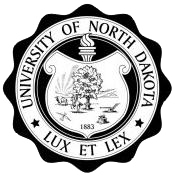
The University of North Dakota is a public research university in Grand Forks, North Dakota. It was established by the Dakota Territorial Assembly in 1883, six years before the establishment of the state of North Dakota.

Allen Harold "Al" Neuharth was an American businessman, author, and columnist born in Eureka, South Dakota. He was the founder of USA Today, The Freedom Forum, and its Newseum.
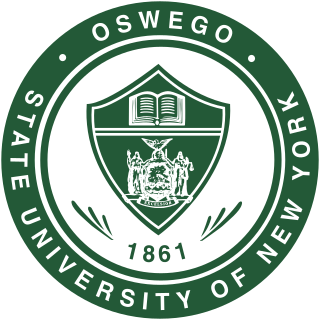
State University of New York at Oswego is a public university in the City of Oswego and Town of Oswego, New York. It has two campuses: historic lakeside campus in Oswego and Metro Center in Syracuse, New York.

Eastern Illinois University (EIU) is a public university in Charleston, Illinois. Established in 1895 as the Eastern Illinois State Normal School, a teacher's college offering a two-year degree, Eastern Illinois University gradually expanded into a comprehensive university with a broad curriculum, including bachelor's and master's degrees in education, business, arts, sciences, and humanities.

East Tennessee State University (ETSU) is a public research university in Johnson City, Tennessee. It was historically part of the State University and Community College System of Tennessee under the Tennessee Board of Regents, but since 2016, the university has been transitioning to governance by a separate institutional Board of Trustees. As of May 2017, it is the fourth largest university in the state and has off-campus centers in nearby Kingsport, Elizabethton, and Sevierville.

Dakota State University (DSU) is a public university in Madison, South Dakota. The school was founded in 1881 as a normal school, or teacher training school. Education is still the university's heritage mission, but a signature mission of technology was added by the state legislature in 1984 to specialize in "programs in computer management, computer information systems, and other related undergraduate and graduate programs."

Black Hills State University (BHSU) is a public university in Spearfish, South Dakota. Close to 4,000 students attend classes at its 123-acre (50 ha) campus in Spearfish, with a satellite campus in Rapid City that is shared with South Dakota State University, and through distance offerings. Enrollment comes from 64 out of 66 counties in South Dakota, 43 states, and 29 countries. BHSU is governed by the South Dakota Board of Regents.

The DakotaDome is an indoor multi-purpose stadium in the north central United States, located on the campus of the University of South Dakota in Vermillion, South Dakota. Opened 44 years ago in 1979 at a cost of $8.2 million, the 9,100-seat venue is the home of the South Dakota Coyotes for football, swimming and diving, and track and field. The approximate elevation is 1,220 feet (370 m) above sea level.
William Ogden "Doc" Farber was an American political scientist, professor emeritus at the University of South Dakota, and founder of the South Dakota Legislative Research Council. Notable protégés that credit his teachings as influences include Tom Brokaw, Al Neuharth, Dennis Daugaard, Dusty Johnson, and Pat O'Brien.

The South Dakota Coyotes, also known as the USD Coyotes, are the athletic teams for the University of South Dakota. Their team colors are vermilion and white. They have been members of Summit League of the NCAA's Division I since the 2011–12 school year. The football team plays in Division I's Football Championship Subdivision as a member of the Missouri Valley Football Conference. The Coyotes were charter members of the Division II North Central Conference and were members until 2008 when it upgraded to Division I.
KAOR is an American student-run non-commercial educational radio station licensed to serve Vermillion, South Dakota, United States. The station is owned by the University of South Dakota.

The South Dakota–South Dakota State football rivalry between the South Dakota Coyotes and the South Dakota State Jackrabbits is a yearly rivalry match-up in football between the two largest public universities in the state of South Dakota: the University of South Dakota in Vermillion and South Dakota State University in Brookings.
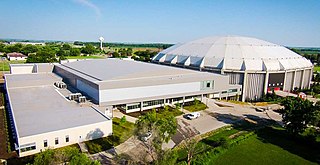
The Sanford Coyote Sports Center is an indoor arena located on the campus of the University of South Dakota (USD) in Vermillion, South Dakota. The facility opened in 2016 and hosts the university's men's basketball, women's basketball, and women's volleyball teams. It has a seating capacity of 6,000. The center is named after a major supporter of the athletic program, Sanford Health, which donated $20 million to help with construction of the facility.
The 1951 South Dakota Coyotes football team was an American football team that represented the University of South Dakota as a member of the North Central Conference (NCC) during the 1951 college football season. In their 14th season under head coach Harry Gamage, the Coyotes compiled a 7–1 record, outscored opponents by a total of 218 to 107, and won the NCC championship.


































